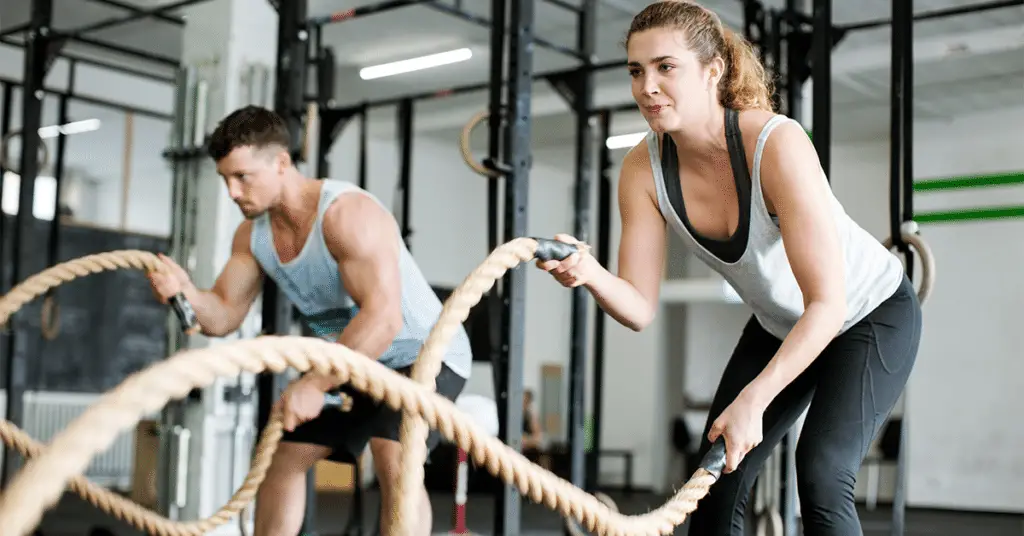Introduction
In the ever-evolving landscape of fitness and exercise regimens, CrossFit has emerged as a dynamic and challenging approach that captivates the attention of those seeking effective weight loss solutions. With its high-intensity workouts, functional movements, and a vibrant community of enthusiasts, CrossFit has garnered a reputation as a potent tool for shedding pounds and achieving fitness goals.The question of whether CrossFit is indeed effective for weight loss is a topic of keen interest and discussion among fitness enthusiasts and experts. To navigate this inquiry, we will embark on a comprehensive exploration of CrossFit’s principles, methodologies, and potential impact on weight management.
In this journey, we will delve into the science behind CrossFit, scrutinize its ability to torch calories, and assess its potential to build lean muscle mass – a key factor in sustained weight loss. Moreover, we will uncover the experiences and success stories of individuals who have embraced CrossFit as a pathway to shedding excess pounds and achieving a healthier, more active lifestyle.So, let us embark on this quest to unveil the truth about whether CrossFit is a compelling and sustainable strategy for weight loss, and discover the insights that may empower you on your own fitness journey.
CrossFit can be an effective tool for weight loss due to its high-intensity workouts and multifaceted approach to fitness. These workouts often incorporate elements of strength training, cardio, and functional movements, making them calorie-intensive and beneficial for burning fat. CrossFit’s emphasis on full-body, compound exercises engages multiple muscle groups simultaneously, potentially increasing muscle mass and metabolic rate. Moreover, the varied and challenging nature of CrossFit workouts keeps participants engaged and motivated, helping to avoid workout plateaus. The sense of community and camaraderie within CrossFit gyms can provide valuable support and accountability, encouraging individuals to stay committed to their weight loss goals. While CrossFit can be a valuable component of a weight loss plan, it should be complemented by a balanced diet and overall lifestyle changes for optimal and sustainable results.

How many times a week should you do CrossFit to lose weight?
Do You Want to Lose Weight? If you want to lose weight, doing CrossFit a minimum of three times per week can help you achieve your goal. However, it’s important to note that class frequency is just one part of the equation when it comes to losing weight.To lose weight through CrossFit, it’s generally recommended to attend CrossFit classes a minimum of three times per week. However, weight loss is influenced by multiple factors, including diet, overall physical activity, and individual metabolism. While regular CrossFit workouts can be an effective component of a weight loss plan, achieving and maintaining weight loss also depends on maintaining a calorie deficit through a balanced diet and lifestyle. Consulting with a CrossFit coach or fitness professional can help you create a personalized workout and nutrition plan tailored to your weight loss goals and needs.
Why do I not lose weight doing CrossFit?
“The people that just do CrossFit and don’t have a nutrition plan do not lose weight,” says Zuffelato. “When they get serious with the CrossFit program their appetite goes into overdrive and without a proper plan, they don’t see any sustained weight loss.Not losing weight while doing CrossFit can be attributed to several factors, and diet is a crucial one.
Here are some reasons why weight loss might not occur with CrossFit:
Dietary Choices: Nutrition plays a significant role in weight loss. If your diet is not aligned with your weight loss goals, it can hinder your progress. Overeating or making poor food choices can offset the calorie burn from CrossFit workouts.
Caloric Intake: Even with intense CrossFit workouts, if you consume more calories than you burn, you may not create the necessary calorie deficit for weight loss. Tracking and managing your calorie intake is essential.
Appetite Increase: Intense exercise can stimulate appetite, causing some individuals to eat more than they burn, negating the calorie deficit needed for weight loss.
Nutrient Timing: The timing of meals and snacks in relation to your workouts can impact weight loss. Consuming the right nutrients before and after a workout can optimize fat burning and muscle recovery.
Hydration: Dehydration can sometimes be mistaken for hunger, leading to overeating. Staying properly hydrated is essential for managing appetite.
What is the best diet for CrossFit?
The CrossFit website recommends the Zone Diet, which is designed to stabilize blood sugar and minimize inflammation. A typical meal is made of 2/3 healthy carbs, 1/3 lean protein and a small amount of monounsaturated fat.
The best diet for CrossFit, like any fitness program, should provide the necessary nutrients to support energy, performance, and recovery. While individual dietary preferences and needs can vary, there are several diet options that CrossFit enthusiasts commonly follow.
Zone Diet: The Zone Diet, as recommended by the CrossFit website, focuses on stabilizing blood sugar levels and minimizing inflammation. A typical Zone Diet meal consists of approximately 2/3 healthy carbohydrates, 1/3 lean protein, and a small amount of monounsaturated fat. This balanced approach can provide sustained energy for CrossFit workouts.
Paleo Diet: The Paleo diet emphasizes whole, unprocessed foods similar to what our ancestors might have eaten, including lean meats, fish, fruits, vegetables, nuts, and seeds. It avoids grains, dairy, and processed foods. Many CrossFit practitioners find success with this diet due to its focus on whole foods.
Flexible Dieting (IIFYM): If It Fits Your Macros (IIFYM) allows for more flexibility in food choices as long as you meet specific macronutrient (carbohydrates, proteins, fats) and calorie targets. This approach can be adjusted to support CrossFit training goals.
Mediterranean Diet: The Mediterranean diet emphasizes fruits, vegetables, whole grains, lean protein sources (like fish and poultry), and healthy fats (olive oil and nuts). It is known for its potential benefits for heart health and can provide a balanced approach to nutrition.
Balanced Macronutrient Diet: Many CrossFit athletes follow a diet that includes a balance of carbohydrates, protein, and healthy fats, tailored to their individual needs and performance goals. This approach focuses on nutrient timing to support workouts and recovery.
How many days per week should I do CrossFit?
Most CrossFit enthusiasts follow a three-day-on, one-day-off and two-day-on schedule for their workouts. It means working out from Monday to Wednesday, taking a rest day or active recovery day on Thursday, and finishing the exercises on Friday and Saturday.The frequency of your CrossFit workouts can vary based on your fitness level, goals, and recovery capacity. The schedule you mentioned, a three-days-on, one-day-off, and two-days-on routine, is a common approach and can be effective for many individuals.
Here’s a breakdown of this schedule:
Monday to Wednesday: Three consecutive days of CrossFit workouts, allowing you to target different muscle groups and fitness modalities.
Thursday: A designated rest day or active recovery day. Active recovery might involve light activities like walking, stretching, or yoga to aid in muscle recovery.
Friday and Saturday: Two additional days of CrossFit workouts, potentially targeting different aspects of fitness or skills compared to the earlier part of the week.
Should I eat before or after CrossFit?
After your workout, your body tries to rebuild its glycogen stores as well as repair and regrow those muscle proteins. Eating soon after you exercise can help your body get this done faster. Your prime window of opportunity to refuel is 45 minutes to 2 hrs post workout.
Eating both before and after CrossFit workouts can be beneficial for optimizing performance, recovery, and overall fitness goals. Here’s a breakdown of when to eat.
Before CrossFit:
Pre-Workout Meal: Eating a balanced meal 1 to 3 hours before your CrossFit session can provide the necessary energy and nutrients for optimal performance. Include carbohydrates for energy, protein for muscle support, and a small amount of healthy fats.
Snack Option: If you’re short on time, a light snack 30 minutes to an hour before the workout can provide a quick energy boost. Consider options like a banana, a granola bar, or yogurt.
After CrossFit:
Post-Workout Nutrition: Eating within the 45-minute to 2-hour window after your CrossFit workout is essential for muscle recovery and replenishing glycogen stores. This meal or snack should include carbohydrates to restore energy, protein to aid in muscle repair, and fluids to rehydrate.
Protein-Rich Meal: Within a few hours after your workout, aim for a balanced meal with lean protein sources (chicken, fish, tofu), complex carbohydrates (brown rice, quinoa, sweet potatoes), and vegetables.
Hydration: Rehydrating with water or a sports drink that includes electrolytes can help replace fluids lost during exercise.
Is CrossFit better in the morning or Evening?
If you are trying to lose weight and burn fat, a morning workout may be your best bet. If you are more focused on performance, for example playing tennis or CrossFit, you may have more energy during an afternoon workout.
preferences, energy levels, and fitness goals. Here are some factors to consider for both time slots.
Morning CrossFit:
Metabolism Boost: Morning workouts can kickstart your metabolism and potentially help with weight loss and fat burning throughout the day.
Consistency: Morning workouts can become a consistent part of your daily routine since they are less likely to be affected by work or social commitments.
Energy Levels: Some individuals have high energy levels in the morning and find that they perform well during CrossFit sessions.
Appetite Control: Exercising in the morning may help control your appetite and food choices throughout the day.
Evening CrossFit:
Increased Strength: Some people experience greater strength and power in the evening due to increased body temperature and muscle flexibility.
Performance: If you’re primarily focused on performance and want to lift heavier weights or achieve personal bests, evening workouts may be more suitable.
Stress Relief: Evening workouts can serve as a stress reliever after a long day, helping you unwind and improve your mood.
Community and Socialization: Evening CrossFit classes may have a larger attendance, providing more opportunities for social interaction and community support.
What is the best age to start CrossFit?
CrossFit is a methodology, in theory, that can be safe, sustainable, and modifiable for people of all ages and abilities. This would include your 14 year old nephew. However, CrossFit is also an extreme sport where injury and overtraining occur often.The best age to start CrossFit can vary based on individual readiness, maturity, and physical development. CrossFit is designed to be scalable and adaptable to various fitness levels and age groups.
Here are some considerations for different age ranges:
Youth (Teenagers): Many CrossFit gyms offer programs specifically designed for teenagers, typically starting around ages 12 to 14. These programs focus on functional movements, fitness fundamentals, and age-appropriate strength and conditioning. It’s essential for teenagers to receive proper coaching and supervision to ensure safety and technique.
Young Adults (Late Teens to Early 20s): Young adults who are physically mature and have a good foundation of movement patterns can safely participate in regular CrossFit classes. Proper coaching and guidance are crucial to prevent overtraining and injuries.
Adults (Mid-20s and Beyond): CrossFit is suitable for adults of all ages, and many individuals begin their CrossFit journey in their mid-20s or later. The key is to start at an appropriate fitness level, progress gradually, and prioritize proper form and technique.
Seniors (60+): CrossFit can also benefit seniors by improving functional fitness, mobility, and overall health. Specialized programs for older adults may focus on low-impact movements and modifications to accommodate age-related factors.
Should I drink a protein shake before CrossFit?
Having that protein pre-workout can be a good thing as it can be absorbed quickly and transported to muscle cells to promote growth. If you haven’t eaten for a few hours before your workout, then consuming protein before you hit the gym can help you feel fuller and satiated.
Muscle Recovery and Growth: Consuming protein before a workout can provide your muscles with amino acids, which are the building blocks of protein. This can potentially enhance muscle recovery and support muscle growth, especially if you have not eaten for several hours before your workout.
Satiety: Protein is known for its satiating effect, which means it can help you feel fuller and more satisfied. If you are working out in a fasted state or if your last meal was a while ago, a protein shake before CrossFit can help provide energy and reduce hunger during the workout.
Energy: Protein, along with carbohydrates, can provide a source of energy for your CrossFit session. Some individuals find that a protein shake with a small amount of carbohydrates provides sustained energy for their workouts.
Personal Preference: Your preference and tolerance for food before exercise play a significant role. Some people feel comfortable working out on an empty stomach, while others prefer to have a small meal or shake before their session.
If you decide to have a protein shake before CrossFit, consider the following:
Timing: Consume the shake about 30 minutes to an hour before your workout to allow for digestion and nutrient absorption.
Composition: Include both protein and a small amount of carbohydrates for sustained energy. Opt for a high-quality protein source, such as whey or plant-based protein, and avoid excessive fats and fiber that can slow digestion.
Hydration: Ensure you are well-hydrated before your workout, as protein shakes can be dehydrating.
Personal Response: Pay attention to how your body responds to pre-workout nutrition. Experiment with different timing and composition to find what works best for your energy levels and performance.

Conclusion
CrossFit can indeed be an effective strategy for weight loss. Its intense, multifaceted workouts incorporate strength training, cardiovascular conditioning, and functional movements, which collectively contribute to calorie burning and muscle building. These high-intensity workouts have the potential to elevate your metabolism, leading to increased fat loss over time.What sets CrossFit apart is its focus on constantly varied workouts, preventing the body from adapting to routine exercises and promoting continuous progress.
Moreover, the sense of community and competition within CrossFit gyms can boost motivation and adherence to regular exercise, essential for weight loss success.However, it’s crucial to complement CrossFit with a balanced diet to achieve weight loss goals. Nutrition plays a pivotal role, and a calorie deficit is necessary for shedding pounds. Safety and proper form are also paramount, as the intensity of CrossFit can increase the risk of injury if exercises are not performed correctly.
In summary, CrossFit can be a valuable component of a weight loss plan, offering both physical benefits and a supportive community. To maximize its effectiveness, combine it with sound nutrition, adequate rest, and personalized guidance from certified trainers.It’s important to note that while CrossFit can be highly effective for weight loss, it should be combined with a well-balanced diet and lifestyle factors such as sleep and stress management.

